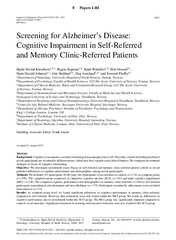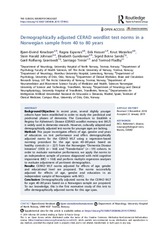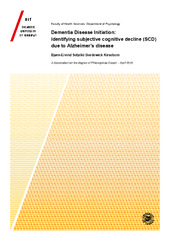| dc.contributor.advisor | Waterloo, Knut | |
| dc.contributor.author | Kirsebom, Bjørn-Eivind | |
| dc.date.accessioned | 2019-04-26T10:59:16Z | |
| dc.date.available | 2019-04-26T10:59:16Z | |
| dc.date.issued | 2019-05-20 | |
| dc.description.abstract | Background: Alzheimer’s disease (AD) may develop 10-15 years before onset of mild cognitive impairment (MCI). Early intervention may serve to halt or delay disease progression. Thus, there is a need to investigate early cognitive and biological markers to detect and track disease progression. Subjective cognitive decline (SCD) is an established risk-factor for AD. However, SCD is a common phenomenon in healthy aging, and most cases are benign. Thus, improved methods of identifying and tracking SCD due to AD are needed.
Objectives/aims: This thesis investigates the role of SCD as a preclinical stage of AD and seeks to improve methods of early detection. In paper I, potential recruitment source biases in demographics and cognitive performance between memory-clinic referred and self-referred SCD and MCI cases were investigated. In paper II, the cerebrospinal fluid (CSF) Neurogranin/BACE1 ratio was explored as a biomarker of putatively AD-coupled synapse affection in SCD and MCI cases with amyloid plaques. In paper III, more sensitive and culturally adapted test norms for the Consortium to Establish a Registry for Alzheimer’s Disease (CERAD) word list episodic memory test (WLT) was developed.
Methods: Participants were primarily drawn from the Norwegian “Dementia Disease Initiation (DDI)” study comprising 658 baseline and 428 follow-up participants. An additional 59 healthy controls were included from the Norwegian “Trønderbrain” study for the purpose of developing cognitive test norms.
Results and conclusions: In paper I, we found that both the SCD and MCI groups, regardless of recruitment method, showed reduced cognitive performance compared to controls. Differences in cognitive impairment for memory clinic-referrals compared to self-referrals were found only within the MCI group. In this study, a need to establish new test norms for the episodic memory test, CERAD WLT was revealed, which were ultimately developed in paper III. The CSF Neurogranin/BACE1 ratio was increased in SCD and MCI cases with amyloid plaques. Increased ratios were related to reductions in hippocampal and amygdala volumes, corresponding to cognitive impairment at baseline and decline at 2-year follow-up. The Neurogranin/BACE1 ratio holds promise as a preclinical AD marker of synapse loss. | en_US |
| dc.description.doctoraltype | ph.d. | en_US |
| dc.description.popularabstract | Alzheimer’s disease is the leading cause of dementia and comprising between 50-75 % of cases. The biological underpinnings of Alzheimer’s disease may begin 10 – 15 years before the disease manifests as objective deficits in cognition. Discovering disease markers at this early preclinical stage will increase our understanding of early disease mechanisms and hopefully lead to the development of interventions that can prevent, halt or stop disease progression. Succeeding in this task would be of enormous benefit to patients, caregivers and society as a whole. The experience of subjective cognitive decline is a known risk factor for Alzheimer’s disease development. However, most cases are indeed benign and a part of normal aging. This thesis aimed to investigate the role of subjective cognitive decline as a preclinical stage of Alzheimer’s disease.
We sought to improve early detection of at-risk individuals by investigating potential biases in participant recruitment methods, improve tools for assessment of memory performance, and investigate a new cerebrospinal fluid biomarker, the neurogranin/BACE1 ratio, which may be tied to synapse loss in Alzheimer’s disease. Synapses are the primary connections between nerve cells, and loss of these connections lead to cognitive decline. The experience of subjective cognitive decline in patients with Alzheimer’s disease could be due to early loss of synapses that have yet to reach the threshold for objective cognitive deficits and present a possibility for early intervention.
We found that patients recruited from memory clinics, may be at higher risk of Alzheimer’s disease compared to volunteer participants from the community. This may be due to increased worry tied to subjective cognitive decline, or concerns voiced from their caregivers prompting patients to seek medical help. Our findings have important implications for participant recruitment, especially when recruiting at-risk individuals for medical intervention trials. Importantly, this may have implications for general practitioners seeing worried, but cognitive healthy patients with subjective cognitive decline. Memory performance is a central part of Alzheimer’s disease research. In this thesis, we developed more sensitive and culturally adapted test norms for a much used test of verbal memory performance. This will lead to a more accurate assessment of verbal memory performance in the clinic, and help clinicians determine normal from abnormal memory performance. Our research confirmed that the neurogranin/BACE1 ratio may indeed be a promising marker for synapse loss due to Alzheimer’s disease even at the preclinical phase of the disease. Our findings suggest that increased levels of this marker predict future cognitive decline and may point to the loss synapses as an early disease event. This finding could open possibilities for interventions aimed at preventing early synapse loss. Such future intervention could slow the progress of cognitive decline due to Alzheimer’s disease. | en_US |
| dc.description.sponsorship | Helse-Nord | en_US |
| dc.identifier.uri | https://hdl.handle.net/10037/15234 | |
| dc.language.iso | eng | en_US |
| dc.publisher | UiT The Arctic University of Norway | en_US |
| dc.publisher | UiT Norges arktiske universitet | en_US |
| dc.relation.haspart | <p>Paper I: Kirsebom, B-E., Espenes, R., Waterloo, K., Hessen, E., Johnsen, S. H., Bråthen, G. … Fladby, T. (2017). Screening for Alzheimer's Disease: Cognitive Impairment in SelfReferred and Memory Clinic-Referred Patients. <i>Journal of Alzheimer's Disease, 60</i>(4), 1621-1631. Also available at <a href=https://hdl.handle.net/10037/15230> https://hdl.handle.net/10037/15230. </a> <p>
<p>Paper II: Kirsebom, B-E., Nordengen, K., Selnes, P., Waterloo, K., Torsetnes, S.B., Gísladóttir, B., Brix, B. … Fladby, T. (2018). Cerebrospinal fluid neurogranin/β-site APP-cleaving enzyme 1 predicts cognitive decline in preclinical Alzheimer's disease. <i>Alzheimer's & Dementia: Translational Research & Clinical Interventions, 4</i>, 617-627. Also available at <a href=https://hdl.handle.net/10037/15232>https://hdl.handle.net/10037/15232.</a> <p>
<p>Paper III: Kirsebom, B-E., Espenes, R., Hessen, E., Waterloo, K., Johnsen, S.H., Gundersen, G. … Fladby, T. (2019). Demographically adjusted CERAD wordlist test norms in a Norwegian sample from 40 to 80 years. <i>The Clinical Neuropsychologist</i>. Also available at <a href=https://hdl.handle.net/10037/15233>https://hdl.handle.net/10037/15233. </a><p> | en_US |
| dc.rights.accessRights | openAccess | en_US |
| dc.rights.holder | Copyright 2019 The Author(s) | |
| dc.rights.uri | https://creativecommons.org/licenses/by-nc-sa/3.0 | en_US |
| dc.rights | Attribution-NonCommercial-ShareAlike 3.0 Unported (CC BY-NC-SA 3.0) | en_US |
| dc.subject | VDP::Samfunnsvitenskap: 200::Psykologi: 260::Klinisk psykologi: 262 | en_US |
| dc.subject | VDP::Social science: 200::Psychology: 260::Clinical psychology: 262 | en_US |
| dc.subject | VDP::Samfunnsvitenskap: 200::Psykologi: 260::Biologisk psykologi: 261 | en_US |
| dc.subject | VDP::Social science: 200::Psychology: 260::Biological psychology: 261 | en_US |
| dc.title | Dementia Disease Initiation: Identifying subjective cognitive decline (SCD) due to Alzheimer’s disease | en_US |
| dc.type | Doctoral thesis | en_US |
| dc.type | Doktorgradsavhandling | en_US |


 English
English norsk
norsk




